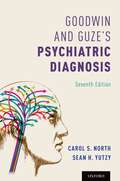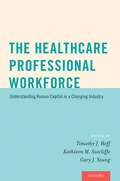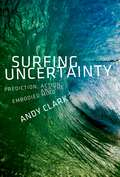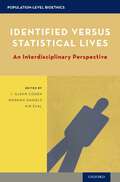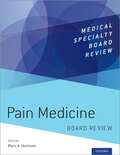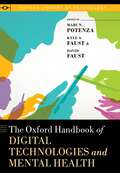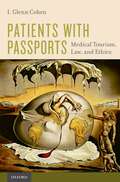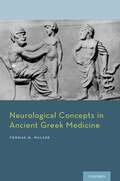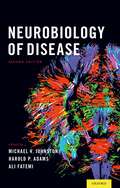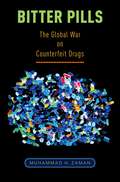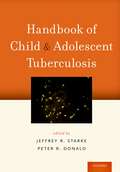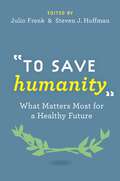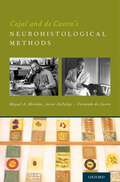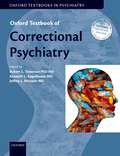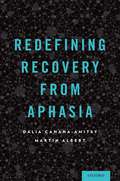- Table View
- List View
Goodwin and Guze's Psychiatric Diagnosis 7th Edition
by Dr Carol North Dr Sean YutzyAcclaimed for its thorough yet concise overview of the natural history of psychiatric disorders, Goodwin & Guze's Psychiatric Diagnosis has been newly and extensively updated in this seventh edition. As in previous editions, each chapter systematically covers the definition, historical background, epidemiology, clinical picture, natural history, complications, family studies, differential diagnosis, and clinical management of each disorder. Terminology has been updated for consistency with changes made in DSM-5®. Recent epidemiologic and neurobiological findings are provided, including the long term course of mood disorders, genetics and neuroimaging of schizophrenia and mood and other disorders, cognitive changes in relation to depression and dementia, brain stimulation techniques, outcome studies of eating disorders, and epidemiology of substance use disorders.
Goodwin and Guze's Psychiatric Diagnosis 7th Edition
by Dr Carol North Dr Sean YutzyAcclaimed for its thorough yet concise overview of the natural history of psychiatric disorders, Goodwin & Guze's Psychiatric Diagnosis has been newly and extensively updated in this seventh edition. As in previous editions, each chapter systematically covers the definition, historical background, epidemiology, clinical picture, natural history, complications, family studies, differential diagnosis, and clinical management of each disorder. Terminology has been updated for consistency with changes made in DSM-5®. Recent epidemiologic and neurobiological findings are provided, including the long term course of mood disorders, genetics and neuroimaging of schizophrenia and mood and other disorders, cognitive changes in relation to depression and dementia, brain stimulation techniques, outcome studies of eating disorders, and epidemiology of substance use disorders.
The Healthcare Professional Workforce: Understanding Human Capital in a Changing Industry
by Timothy J. Hoff Kathleen M. Sutcliffe Gary J. YoungAs the U.S. healthcare industry undergoes sweeping changes to increase efficiency and reduce costs, the healthcare workforce is changing as well. In this new system of care, physicians work alongside health care teams, where nurses, pharmacists, and other professionals must collaborate to provide better, more affordable care to many more patients than ever before. The HEALTHCARE PROFESSIONAL WORKFORCE is the first book to codify the transformations underway across health professions in the U.S. and to situate these changes within a larger context for both healthcare and non-healthcare audiences. This volume provides an important guide to understanding how health professionals fit within the emerging model of healthcare, and serves as a vital resource for readers in health policy management, medicine, public health, and organizational studies. Comprising seven unique chapters alongside commentaries from heads of healthcare organizations and influential physicians, THE HEALTHCARE PROFESSIONAL WORKFORCE provides a theoretical and practical benchmark for understanding the next generation of human capital in one of society's most important labor sectors.
The Healthcare Professional Workforce: Understanding Human Capital in a Changing Industry
by Kathleen M. Sutcliffe Gary J. Young Timothy J. HoffAs the U.S. healthcare industry undergoes sweeping changes to increase efficiency and reduce costs, the healthcare workforce is changing as well. In this new system of care, physicians work alongside health care teams, where nurses, pharmacists, and other professionals must collaborate to provide better, more affordable care to many more patients than ever before. The HEALTHCARE PROFESSIONAL WORKFORCE is the first book to codify the transformations underway across health professions in the U.S. and to situate these changes within a larger context for both healthcare and non-healthcare audiences. This volume provides an important guide to understanding how health professionals fit within the emerging model of healthcare, and serves as a vital resource for readers in health policy management, medicine, public health, and organizational studies. Comprising seven unique chapters alongside commentaries from heads of healthcare organizations and influential physicians, THE HEALTHCARE PROFESSIONAL WORKFORCE provides a theoretical and practical benchmark for understanding the next generation of human capital in one of society's most important labor sectors.
Surfing Uncertainty: Prediction, Action, and the Embodied Mind
by Andy ClarkHow is it that thoroughly physical material beings such as ourselves can think, dream, feel, create and understand ideas, theories and concepts? How does mere matter give rise to all these non-material mental states, including consciousness itself? An answer to this central question of our existence is emerging at the busy intersection of neuroscience, psychology, artificial intelligence, and robotics. In this groundbreaking work, philosopher and cognitive scientist Andy Clark explores exciting new theories from these fields that reveal minds like ours to be prediction machines - devices that have evolved to anticipate the incoming streams of sensory stimulation before they arrive. These predictions then initiate actions that structure our worlds and alter the very things we need to engage and predict. Clark takes us on a journey in discovering the circular causal flows and the self-structuring of the environment that define "the predictive brain." What emerges is a bold, new, cutting-edge vision that reveals the brain as our driving force in the daily surf through the waves of sensory stimulation.
Surfing Uncertainty: Prediction, Action, and the Embodied Mind
by Andy ClarkHow is it that thoroughly physical material beings such as ourselves can think, dream, feel, create and understand ideas, theories and concepts? How does mere matter give rise to all these non-material mental states, including consciousness itself? An answer to this central question of our existence is emerging at the busy intersection of neuroscience, psychology, artificial intelligence, and robotics. In this groundbreaking work, philosopher and cognitive scientist Andy Clark explores exciting new theories from these fields that reveal minds like ours to be prediction machines - devices that have evolved to anticipate the incoming streams of sensory stimulation before they arrive. These predictions then initiate actions that structure our worlds and alter the very things we need to engage and predict. Clark takes us on a journey in discovering the circular causal flows and the self-structuring of the environment that define "the predictive brain." What emerges is a bold, new, cutting-edge vision that reveals the brain as our driving force in the daily surf through the waves of sensory stimulation.
Identified versus Statistical Lives: An Interdisciplinary Perspective (Population-Level Bioethics)
by I. Glenn Cohen Norman Daniels Nir EyalThe identified lives effect describes the fact that people demonstrate a stronger inclination to assist persons and groups identified as at high risk of great harm than those who will or already suffer similar harm, but endure unidentified. As a result of this effect, we allocate resources reactively rather than proactively, prioritizing treatment over prevention. For example, during the August 2010 gold mine cave-in in Chile, where ten to twenty million dollars was spent by the Chilean government to rescue the 33 miners trapped underground. Rather than address the many, more cost effective mine safety measures that should have been implemented, the Chilean government and international donors concentrated efforts in large-scale missions that concerned only the specific group. Such bias as illustrated through this incident raises practical and ethical questions that extend to almost every aspect of human life and politics. What can social and cognitive sciences teach us about the origin and triggers of the effect? Philosophically and ethically, is the effect a "bias" to be eliminated or is it morally justified? What implications does the effect have for health care, law, the environment and other practice domains? This volume is the first to take an interdisciplinary approach toward answering this issue of identified versus statistical lives by considering a variety of perspectives from psychology, public health, law, ethics, and public policy.
Identified versus Statistical Lives: An Interdisciplinary Perspective (Population-Level Bioethics)
by I. Glenn Cohen, Norman Daniels and Nir EyalThe identified lives effect describes the fact that people demonstrate a stronger inclination to assist persons and groups identified as at high risk of great harm than those who will or already suffer similar harm, but endure unidentified. As a result of this effect, we allocate resources reactively rather than proactively, prioritizing treatment over prevention. For example, during the August 2010 gold mine cave-in in Chile, where ten to twenty million dollars was spent by the Chilean government to rescue the 33 miners trapped underground. Rather than address the many, more cost effective mine safety measures that should have been implemented, the Chilean government and international donors concentrated efforts in large-scale missions that concerned only the specific group. Such bias as illustrated through this incident raises practical and ethical questions that extend to almost every aspect of human life and politics. What can social and cognitive sciences teach us about the origin and triggers of the effect? Philosophically and ethically, is the effect a "bias" to be eliminated or is it morally justified? What implications does the effect have for health care, law, the environment and other practice domains? This volume is the first to take an interdisciplinary approach toward answering this issue of identified versus statistical lives by considering a variety of perspectives from psychology, public health, law, ethics, and public policy.
Pain Medicine Board Review (Medical Specialty Board Review)
Pain Medicine Board Review is a comprehensive guide for preparing for the American Board of Medical Specialties (ABMS) certification or recertification in Pain Medicine, and for residents preparing for in-training examinations in Pain Medicine. The text is organized into 28 chapters covering topics such as Anatomy, Physiology of Pain, Pharmacology, Diagnosis of Pain, and various pain syndromes. Each section includes questions, answers, and detailed explanations with highlighted key points, and concise further reading lists. Questions follow the ABMS style, and the explications of answers carefully address all points in the ABMS content outline for Pain Medicine. A section on imaging includes high quality magnetic resonance images, ultrasound images, fluoroscopic images and other images that will enable the examination candidate to answer questions that determine knowledge of pathological states as compared to normal and complications of treatments.
Pain Medicine Board Review (Medical Specialty Board Review)
by Marc A. HuntoonPain Medicine Board Review is a comprehensive guide for preparing for the American Board of Medical Specialties (ABMS) certification or recertification in Pain Medicine, and for residents preparing for in-training examinations in Pain Medicine. The text is organized into 28 chapters covering topics such as Anatomy, Physiology of Pain, Pharmacology, Diagnosis of Pain, and various pain syndromes. Each section includes questions, answers, and detailed explanations with highlighted key points, and concise further reading lists. Questions follow the ABMS style, and the explications of answers carefully address all points in the ABMS content outline for Pain Medicine. A section on imaging includes high quality magnetic resonance images, ultrasound images, fluoroscopic images and other images that will enable the examination candidate to answer questions that determine knowledge of pathological states as compared to normal and complications of treatments.
The Oxford Handbook of Digital Technologies and Mental Health (Oxford Library of Psychology)
Digital technology use, whether on smartphones, tablets, laptops, or other devices, is prevalent across cultures. Certain types and patterns of digital technology use have been associated with mental health concerns, but these technologies also have the potential to improve mental health through the gathering of information, by targeting interventions, and through delivery of care to remote areas. The Oxford Handbook of Digital Technologies and Mental Health provides a comprehensive and authoritative review of the relationships between mental health and digital technology use, including how such technologies may be harnessed to improve mental health. Understanding the positive and negative correlates of the use of digital technologies has significant personal and public health implications, and as such this volume explores in unparalleled depth the historical and cultural contexts in which technology use has evolved; conceptual issues surrounding digital technologies; potential positive and potential negative impacts of such use; treatment, assessment, and legal considerations around digital technologies and mental health; technology use in specific populations; the use of digital technologies to treat psychosocial disorders; and the treatment of problematic internet use and gaming. With chapters contributed by leading scientists from around the world, this Handbook will be of interest to those in medical and university settings, students and clinicians, and policymakers.
Patients with Passports: Medical Tourism, Law, and Ethics
by I. Glenn CohenCan your employer require you to travel to India for a hip replacement as a condition of insurance coverage? If injury results, can you sue the doctor, hospital or insurer for medical malpractice in the country where you live? Can a country prohibit its citizens from helping a relative travel to Switzerland for assisted suicide? What about travel for abortion? In Patients with Passports, I. Glenn Cohen tackles these important questions, and provides the first comprehensive legal and ethical analysis of medical tourism. Medical tourism is a growing multi-billion dollar industry involving millions of patients who travel abroad each year to get health care. Some seek legitimate services like hip replacements and travel to avoid queues, save money, or because their insurer has given them an incentive to do so. Others seek to circumvent prohibitions on accessing services at home and go abroad to receive abortions, assisted suicide, commercial surrogacy, or experimental stem cell treatments. In this book, author I. Glenn Cohen focuses on patients traveling for cardiac bypass and other legal services to places like India, Thailand, and Mexico, and analyzes issues of quality of care, disease transmission, liability, private and public health insurance, and the effects of this trade on foreign health care systems. He goes on to examine medical tourism for services illegal in the patient's home country, such as organ purchase, abortion, assisted suicide, fertility services, and experimental stem cell treatments. Here, Cohen examines issues such as extraterritorial criminalization, exploitation, immigration, and the protection of children. Through compelling narratives, expert data, and industry explanations Patients with Passports enables the reader to connect with the most prevalent legal and ethical issues facing medical tourism today.
Neurological Concepts in Ancient Greek Medicine
by Thomas M Walshe, IIINeurological history claims its earliest origins in the 17th century with Thomas Willis's publication of Anatomy of the Brain, coming fully into fruition as a field in the late 1850s as medical technology and advancements allowed for in depth study of the brain. However, many of the foundations in neurology can find the seed of their beginning to a time much earlier than that, to ancient Greece in fact. Neurological Concepts in Ancient Greek Medicine is a collection of essays exploring neurological ideas between the Archaic and Hellenistic eras. These essays also provide historic, intellectual, and cultural context to ancient Greek medical practice and emphasizing the interest in the brain of the early physicians. This book describes source material that is over 2,500 years old and reveals the observational skills of ancient physicians. It provides complete translations of two historic Hippocratic texts: On the Sacred Diseases and On the Wounds of the Head. The book also discusses the Hippocratic Oath and the modern applications of its meaning. Dr. Walshe connects this ancient history, usually buried in medical histories, and shows the ancient Greek notions that are the precursors of our understanding of the brain and nervous system.
Neurological Concepts in Ancient Greek Medicine
by Thomas M Walshe, IIINeurological history claims its earliest origins in the 17th century with Thomas Willis's publication of Anatomy of the Brain, coming fully into fruition as a field in the late 1850s as medical technology and advancements allowed for in depth study of the brain. However, many of the foundations in neurology can find the seed of their beginning to a time much earlier than that, to ancient Greece in fact. Neurological Concepts in Ancient Greek Medicine is a collection of essays exploring neurological ideas between the Archaic and Hellenistic eras. These essays also provide historic, intellectual, and cultural context to ancient Greek medical practice and emphasizing the interest in the brain of the early physicians. This book describes source material that is over 2,500 years old and reveals the observational skills of ancient physicians. It provides complete translations of two historic Hippocratic texts: On the Sacred Diseases and On the Wounds of the Head. The book also discusses the Hippocratic Oath and the modern applications of its meaning. Dr. Walshe connects this ancient history, usually buried in medical histories, and shows the ancient Greek notions that are the precursors of our understanding of the brain and nervous system.
Neurobiology of Disease
by Michael V. Johnston, Harold P. Adams and Ali FatemiThe second edition of Neurobiology of Disease includes nearly 200 articles surveying all major disorders of the nervous system in both adults and children, focusing on relevant diagnosis and treatments from the perspective of cutting edge clinical and basic neurobiological research. Akin to an encyclopedia of every neurologic disorder, this comprehensive work is ideal for graduate and medical school students, residents, and candidates preparing for their board certification examinations. Each chapter is illustrated with detailed figures, supplemented with descriptive and diagnostic tables, and thoroughly referenced for further investigations. The book's editors, Michael V. Johnston, Harold P. Adams Jr., and Ali Fatemi bring their unique expertise in clinical and research neurology to the overall scope of this work. To further enhance the scope and quality of this new edition, the following Section Editors provided oversight of their respective sections: · Movement Disorders-Joel Perlmutter, Washington University · Dementias-David Knopman, Mayo Clinic · Motorneuron Diseases-Merit Cudkowicz, Massachusetts General Hospital · Paroxysmal Disorders-Solomon Moshe, Albert Einstein College of Medicine · Pediatric Neurology and Developmental Disorders-Tanjala Gipson and Deepa Menon, Kennedy Krieger Institute and Johns Hopkins University · Neuroimmunological Diseases-Carlos Pardo-Villamizar, Johns Hopkins University · Cerebrovascular Diseases-Harold P. Adams Jr., University of Iowa · Peripheral and Autonomic Nervous System Disorders and Pain-Nicholas Maragakis, Johns Hopkins University · Neoplastic and Paraneoplastic Diseases-Lisa DeAngelis, Memorial Sloan-Kettering Cancer Center · Infectious Diseases of the Nervous System-Karen L. Roos, Indiana University · Sleep Disturbances-Mark Dyken, University of Iowa · Substance Abuse and Toxicology Disorders-Barry E. Kosofsky, Weill-Cornell University Medical Center · Neurologic Manifestations of Medical Disorders-John C. Probasco, Johns Hopkins University
Bitter Pills: The Global War on Counterfeit Drugs
by Muhammad H. ZamanLong the scourge of developing countries, fake pills are now increasingly common in the United States. The explosion of Internet commerce, coupled with globalization and increased pharmaceutical use has led to an unprecedented vulnerability in the U.S. drug supply. Today, an estimated 80% of our drugs are manufactured overseas, mostly in India and China. Every link along this supply chain offers an opportunity for counterfeiters, and increasingly, they are breaking in. In 2008, fake doses of the blood thinner Heparin killed 81 people worldwide and resulted in hundreds of severe allergic reactions in the United States. In 2012, a counterfeit version of the cancer drug Avastin, containing no active chemotherapy ingredient, was widely distributed in the United States. In early 2013, a drug trafficker named Francis Ortiz Gonzalez was sentenced to prison for distributing an assortment of counterfeit, Chinese-made pharmaceuticals across America. By the time he was arrested, he had already sold over 140,000 fake pills to customers. Even when the U.S. system works, as it mostly does, consumers are increasingly circumventing the safeguards. Skyrocketing health care costs in the U.S. have forced more Americans to become "medical tourists" seeking drugs, life-saving treatments and transplants abroad, sometimes in countries with rampant counterfeit drug problems and no FDA. Bitter Pills will heighten the public's awareness about counterfeit drugs, critically examine possible solutions, and help people protect themselves. Author Muhammad H. Zaman pays special attention to the science and engineering behind both counterfeit and legitimate drugs, and the role of a "technological fix" for the fake drug problem. Increasingly, fake drugs affect us all.
Bitter Pills: The Global War on Counterfeit Drugs
by Muhammad H. ZamanLong the scourge of developing countries, fake pills are now increasingly common in the United States. The explosion of Internet commerce, coupled with globalization and increased pharmaceutical use has led to an unprecedented vulnerability in the U.S. drug supply. Today, an estimated 80% of our drugs are manufactured overseas, mostly in India and China. Every link along this supply chain offers an opportunity for counterfeiters, and increasingly, they are breaking in. In 2008, fake doses of the blood thinner Heparin killed 81 people worldwide and resulted in hundreds of severe allergic reactions in the United States. In 2012, a counterfeit version of the cancer drug Avastin, containing no active chemotherapy ingredient, was widely distributed in the United States. In early 2013, a drug trafficker named Francis Ortiz Gonzalez was sentenced to prison for distributing an assortment of counterfeit, Chinese-made pharmaceuticals across America. By the time he was arrested, he had already sold over 140,000 fake pills to customers. Even when the U.S. system works, as it mostly does, consumers are increasingly circumventing the safeguards. Skyrocketing health care costs in the U.S. have forced more Americans to become "medical tourists" seeking drugs, life-saving treatments and transplants abroad, sometimes in countries with rampant counterfeit drug problems and no FDA. Bitter Pills will heighten the public's awareness about counterfeit drugs, critically examine possible solutions, and help people protect themselves. Author Muhammad H. Zaman pays special attention to the science and engineering behind both counterfeit and legitimate drugs, and the role of a "technological fix" for the fake drug problem. Increasingly, fake drugs affect us all.
Handbook of Child and Adolescent Tuberculosis
Tuberculosis remains one of the most prevalent, deadly, and underdiagnosed infectious diseases in the world. In children, this burden is doubly problematic because of the disease's unique clinical characteristics and its need for special public health and diagnostic techniques. After decades of relative inattention to these factors, childhood tuberculosis has now grown into an important area of competency for child health programs in low-burden areas, including the United States. The Handbook of Child and Adolescent Tuberculosis is a state of the art clinical reference written and edited by the world's leading experts in childhood tuberculosis. It offers clinicians in any geography or setting practical, evidence-based advice on all aspects of the disease, including its natural history, epidemiology, presentation, treatment, and prevention -- all in a format that synthesizes literature with the clinical experience of the leading authorities in this challenging field. As the need for childhood tuberculosis services in child health programs grows, this handbook provides a new benchmark for practitioners and trainees in pediatrics, infectious disease, pulmonary medicine, and public health to better understand this persisting and difficult disease.
Handbook of Child and Adolescent Tuberculosis
by Jeffrey R. Starke and Peter R. DonaldTuberculosis remains one of the most prevalent, deadly, and underdiagnosed infectious diseases in the world. In children, this burden is doubly problematic because of the disease's unique clinical characteristics and its need for special public health and diagnostic techniques. After decades of relative inattention to these factors, childhood tuberculosis has now grown into an important area of competency for child health programs in low-burden areas, including the United States. The Handbook of Child and Adolescent Tuberculosis is a state of the art clinical reference written and edited by the world's leading experts in childhood tuberculosis. It offers clinicians in any geography or setting practical, evidence-based advice on all aspects of the disease, including its natural history, epidemiology, presentation, treatment, and prevention -- all in a format that synthesizes literature with the clinical experience of the leading authorities in this challenging field. As the need for childhood tuberculosis services in child health programs grows, this handbook provides a new benchmark for practitioners and trainees in pediatrics, infectious disease, pulmonary medicine, and public health to better understand this persisting and difficult disease.
To Save Humanity: What Matters Most for a Healthy Future
by Julio Frenk Steven Hoffman"The UN was not created to take mankind to heaven, but to save humanity from hell." --Dag Hammarskjöld, United Nations Secretary-General 1953-1961 The turn of the 21st century was an objective low point in the history of human health: AIDS was scourging Africa, millions of women died each year in child birth, and billions suffered under malnourishment and poverty. In response, the United Nations launched its Millennium Development Goals (MDGs), an ambitious charter that since 2000 has measurably reduced the worldwide burdens of poverty, hunger, and disease. With the MDGs set to expire in 2015, continued progress on these fronts is anything but certain. In addition to the persisting threats of the 20th century, globalization has sped the development of new threats--pandemics, climate change, chronic disease--that now threaten rich and poor countries equally. "To Save Humanity" is a collection of short, honest essays on what single issue matters most for the future of global health. Authored by the world's leading voices from science, politics, and social advocacy, this collection is both a primer on the major issues of our time and a potential blueprint for post-2015 health and development. This unparalleled collection will provide illuminating and thought-provoking reading for anyone invested in our collective future and well-being.
To Save Humanity: What Matters Most for a Healthy Future
by Steven Hoffman Julio Frenk"The UN was not created to take mankind to heaven, but to save humanity from hell." --Dag Hammarskjöld, United Nations Secretary-General 1953-1961 The turn of the 21st century was an objective low point in the history of human health: AIDS was scourging Africa, millions of women died each year in child birth, and billions suffered under malnourishment and poverty. In response, the United Nations launched its Millennium Development Goals (MDGs), an ambitious charter that since 2000 has measurably reduced the worldwide burdens of poverty, hunger, and disease. With the MDGs set to expire in 2015, continued progress on these fronts is anything but certain. In addition to the persisting threats of the 20th century, globalization has sped the development of new threats--pandemics, climate change, chronic disease--that now threaten rich and poor countries equally. "To Save Humanity" is a collection of short, honest essays on what single issue matters most for the future of global health. Authored by the world's leading voices from science, politics, and social advocacy, this collection is both a primer on the major issues of our time and a potential blueprint for post-2015 health and development. This unparalleled collection will provide illuminating and thought-provoking reading for anyone invested in our collective future and well-being.
Cajal and de Castro's Neurohistological Methods
by Miguel A Merchán Javier De Felipe Fernando de CastroCajal and De Castro's Neurohistological Methods provides the first English translation of Fernando de Castro's 1933 publication "Elementos de Técnica Micrográfica del Sistema Nervioso." A student of the famed founder of modern neuroscience, with Santiago Ramon y Cajal also serving as the Editor of the original text, Fernando de Castro recorded all the various protocols that had been used in his laboratory by his students in order to provide a manual of histological procedures specifically designed for the fine structure of the nervous system. This renowned text is virtually unknown in its original form outside the Spanish-speaking world. In a text that reads like a mix between a recipe book and an alchemical manuscript, authors Miguel Merchan, Javier DeFelipe, and Fernando de Castro (descendant of the 1933 publication's author) put the new translation into historical context. This book is also beautifully illustrated with plates of histological techniques, provides a quick guide to new vocabulary, and the author's notes on the translated text. This pivotal work of classic neurohistological techniques is a wonderful addition to the Cajal library.
Cajal and de Castro's Neurohistological Methods
by Miguel A Merchán Javier De Felipe Fernando de CastroCajal and De Castro's Neurohistological Methods provides the first English translation of Fernando de Castro's 1933 publication "Elementos de Técnica Micrográfica del Sistema Nervioso." A student of the famed founder of modern neuroscience, with Santiago Ramon y Cajal also serving as the Editor of the original text, Fernando de Castro recorded all the various protocols that had been used in his laboratory by his students in order to provide a manual of histological procedures specifically designed for the fine structure of the nervous system. This renowned text is virtually unknown in its original form outside the Spanish-speaking world. In a text that reads like a mix between a recipe book and an alchemical manuscript, authors Miguel Merchan, Javier DeFelipe, and Fernando de Castro (descendant of the 1933 publication's author) put the new translation into historical context. This book is also beautifully illustrated with plates of histological techniques, provides a quick guide to new vocabulary, and the author's notes on the translated text. This pivotal work of classic neurohistological techniques is a wonderful addition to the Cajal library.
Oxford Textbook of Correctional Psychiatry (Oxford Textbooks in Psychiatry)
by Robert L. Trestman, Kenneth L. Appelbaum and Jeffrey L. MetznerCorrectional psychiatry has received increasing recognition as an area of practice with unique skills and knowledge. The Oxford Textbook of Correctional Psychiatry brings together American and international experts to provide a comprehensive overview of the field. Students and psychiatric residents will find basic information that prepares them for clinical rotations, and psychiatrists working in jails and prisons will find a detailed review of the complex issues that arise in these settings. The Oxford Textbook of Correctional Psychiatry contains 71 chapters divided into 14 sections. The first three sections address history, structure, and processes including chapters on case law, human rights, ethics, organization and funding of systems, and stages of patient management that cover initial assessments through re-entry. The next three sections review in turn a broad array of management issues, emergencies, and psychopharmacology topics. Among other topics, these sections include chapters on sleep, detoxification, reassessment of community diagnoses and treatments, diversion programs, levels of care, malingering, substance use within facilities, and formulary management. Section seven has chapters on common psychiatric disorders, relevant medical disorders, and pain management. Sections eight through ten focus on psychotherapeutic options, suicide risk management, and addictions treatment. Chapters on aggression, self-injury, and other behavioral challenges appear in Section eleven. Section twelve reviews unique assessment and treatment needs of many distinct population groups. Special topics such as forensics, psychological testing, sexual assaults, quality improvement, training, and research, appear in Section thirteen, followed by a section devoted to current resources in correctional healthcare. The range of topics covered and the number of prominent contributors set this book apart from other available resources. Readers at all stages of their careers will gain the depth of understanding and practical information they need to approach all of the common clinical, organizational, and ethical challenges they face.
Redefining Recovery from Aphasia
by Dalia Cahana-Amitay Martin AlbertThis book focuses on two fundamental aspects of brain-language relations: one concerns the neural organization of language in the healthy brain; the other challenges current approaches to treatment of aphasia and offers a new theory for recovery from aphasia. The essence of the book lies in the phrase neural multifunctionality: the constant and dynamic incorporation of non-linguistic functions into language models of the intact brain. The book makes the claim that language is a construction, created as we use it, and cannot be understood as being supported by neurally based linguistic networks only. Rather, language emerges from the constant and dynamic interaction among neural networks subserving cognitive, affective, and praxic functions with neural networks subserving lexical retrieval (naming), sentence processing (comprehension), and discourse (communication, conversation). In persons with stroke-induced aphasia, neural networks for executive system function, attention, memory, motor system function, visual system function, and emotion interact with neural networks for language to produce the aphasia profile and to influence recovery from aphasia. Consequently, neural multifunctionality in aphasia explains individual differences in the lesion-deficit model and continued recovery over time, redefining the concept of recovery from aphasia and offering new opportunities for treatment.
